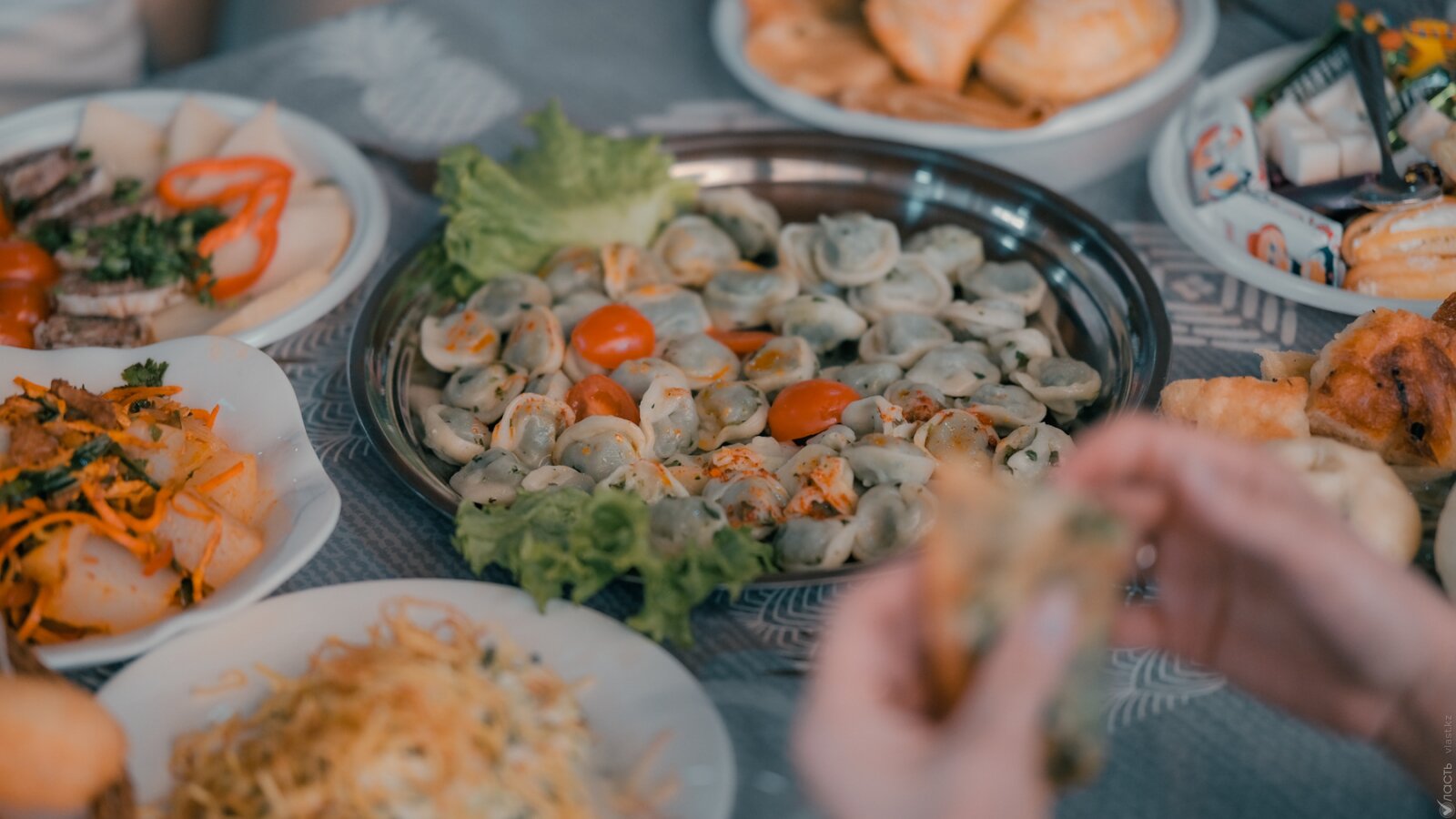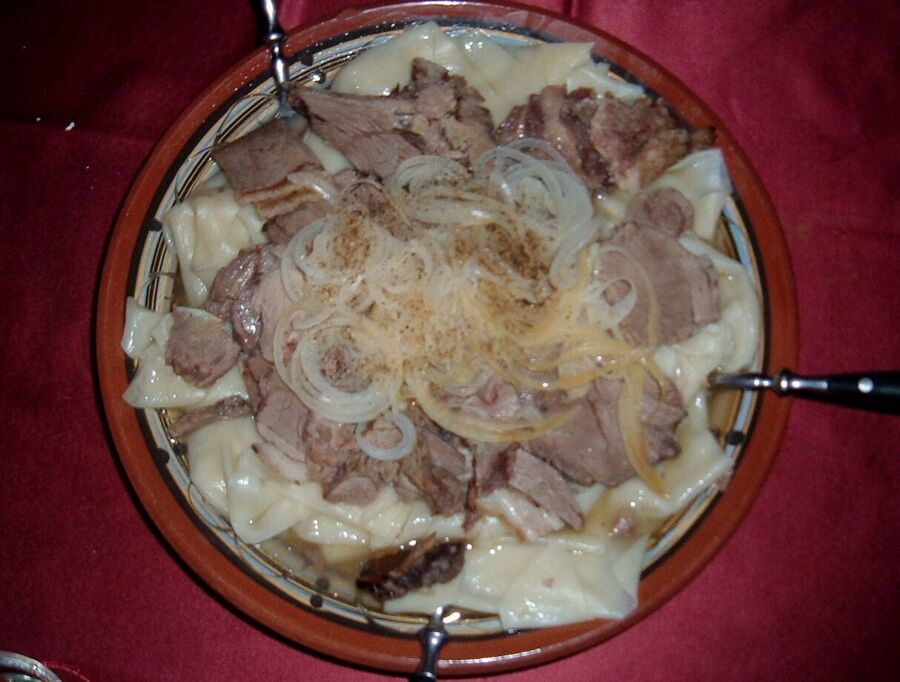After studying Kazakhstan’s food culture and national cuisine, historian Aliya Bolatkhan is now creating a gastronomic map of the country. Vlast interviewed her to talk about the nodes of contention regarding the national cuisine and its contemporary rethinking.
We met Bolatkhan at the Tastak Bazaar in Almaty during a busy weekday. We walked with her to a shashlik restaurant, serving their specialty shish kebab.
“This place is well-known, it has its own regular customers and has retained its unique taste for decades,” Bolatkhan said about the family-owned shop, which has been around since the 1990s.
With little room to sit, the place becomes crowded by noon, as customers form a line outside.
The shashlik has always been a protagonist of the region’s food culture.
“Since the late 1940s, during a time of extensive ethnographic research, textbooks listing the ‘national dishes of Kazakhstan’ included meat, lagman, plov (pilaf), and shashlik,” Bolatkhan said.
According to her, Kazakhstan is not only formed by ethnic Kazakhs, but also includes members of other ethnic groups born and living here. Therefore, what is commonly known as “national cuisine” consists of dishes that are regularly prepared and consumed by all residents of Kazakhstan.
“Of course, most of the dishes that Kazakhs have consumed for centuries are included in our national cuisine. But not all. For example, have you ever tried ‘bürme qaryn’? Coarsely chopped meat, potatoes, and other vegetables and boiled in water with tripe. Nobody cooks this at home, sometimes you can order it in restaurants as ‘authentic food’. Many of us have not tried this dish. Previously, it existed in traditional Kazakh cuisine, but for various reasons it disappeared from mass consumption,” the researcher noted.
Whose Authenticity?
Bolatkhan said unequivocally that “any dish found on any menu in the country should be called ‘national cuisine’.”
“We cook plov, lagman, borscht, and eat kuyrdaq. In some places they make “nan kuyrdaq”, which was very practical in the twentieth century and was possibly created under the influence of the Germans who came here. This dish immediately became popular in food culture because its recipe was easy and everyone loved the taste,” she added.
According to Bolatkhan, modern cuisine has been significantly influenced by the eating habits of the peoples who were deported or moved to Kazakhstan, especially between 1920 and 1950.
For example, the Korean morkovcha (a carrot salad) has turned into an integral part of the local cuisine. Born in Central Asia, manty (steamed dumplings) have since spread to other countries. Despite them being a historical heritage of this region, it is difficult to trace just how their tradition spread across the Silk Road, from Turkey to China and Korea.
“Many of those who were deported to Kazakhstan remained in the country. There were also those who lived here for 15 years, but then left. Still, if you live with someone for 15 years, you will learn a lot from them. Plus, because the Soviet system tried to create a uniform culture, Kazakhstan formed its own cuisine, independent of ethnicity,” the researcher said.
Within the country, regional characteristics have had an influence on food.
“Kazakhs did not live on their own. Fruits and vegetables that they could not produce due to regional characteristics were obtained through exchange and trade. The north and east traded with Russia and China, the south and southeast with other Central Asian countries,” Bolatkhan said.
“By building a menu, through scientific and cultural research, it’s possible to fit a range of different dishes within our country’s traditions. Because we all grew up eating those dishes and we still eat them today. In the end, it’s all about the flavors that evoke emotions and have cultural significance,” concluded Bolatkhan.
National Identity and Food
Within the thriving conversation about decolonization, Bolatkhan said that research on food culture has become even more relevant today.
“Many people argue that language is the main measure of national identity. Yet, in some situations, national identity is determined by other factors as well. Food culture, for example, can be a powerful indicator of your cultural identity,” Bolatkhan argued, adding that the scientific community as well as the government have so far paid little attention to this topic.
Bolatkhan said that people in Kazakhstan still need to come to terms with the transition from a nomadic to a semi-sedentary and then a fully sedentary way of life, which happened alongside periods of colonization, forced collectivization, and famine. These events had a devastating impact on their eating habits.
“All your eating habits are connected to your life path. I collected memories about the ‘taste of childhood’ from people who lived in the post-war decade. They often said that ‘food made from flour, salt and water’ reminded them of their childhood, and for them nothing tastes better. In fact, shelpeks and baursaks (bread fried in oil) are relics of the colonial heritage. We ate this not because it was tasty or healthy, but because at that time there was nothing else. Only over time, this became an integral part of our national identity and traditions,” Bolatkhan said.
Food habits followed the relationship with the colonial power, as seen at the time of the Russian Empire. The use of the name “beshbarmak” (a meal made of chopped meat, dough, and onions) is an image of colonial consciousness that endures today. In earlier times, in fact, Kazakhs called the dish just “et” (Kazakh for “meat”), that is “meat for eating”.
“In 2015, when we cooked the largest beshbarmak, in an effort to enter into the Guinness Book of Records, we publicized it with the name “beshbarmak”. The name became widespread thanks to social media and the government chose it as the official way to present it to a global audience. And so we all started using it as if it was the original name,” Bolatkhan noted.
Historically, however, the name came from a Tatar-Bashkir translation of the first food exchanges once parts of today’s Kazakhstan were annexed to the Russian Empire.
“Representatives of the empire were ordered to eat with their hands. Thus the dish became known as ‘bish barmak’ (‘five fingers’ in the Tatar and Bashkir languages). And so Russians called this dish ‘bishbarmak’ for half a century,” Bolatkhan said.
And it also looked different, because meat was prepared without any dough, until the transition to a more sedentary way of life led to the development of agriculture.
Russian speakers only used the word “beshparmak” after a study by the imperial official Alexei Levshin, who described it as a festive food specific to the West of Kazakhstan. With time, people who liked it began to use it as a blanket term.
“The name ‘beshbarmak’ spread with the Russification during the late Soviet period. In Kazakh, in fact, the correct spelling would be ‘bes barmak’ (and so it was spelled until the 1970s),” Bolatkhan said.
Kazakh-speaking academics voiced their opposition to this misrepresentation, but their complaints fell on deaf ears.
“One of them was Khalel Argynbayev, who pointed out in 1968 in Soviet Ethnography that the name of the Kazakh national dish is ‘et’, and that calling it ‘beshbarmak’ was a mistake. The complete dismissal of these preferences shows how little the opinion of the Kazakh-speaking population was taken into account at that time,” Bolatkhan argued.
The Aftertaste of Colonization
Central Asian societies are still suffering from the effects of colonization on their food culture and habits.
“Every country builds its identity from a Soviet point of view. Because we were taught to think that way and we were used to being defined by others according to their standards,” Bolatkhan said, adding that this now turned into petty fights about the “true” origin of beshbarmak or other dishes.
“Kazakhstan’s national cuisine now includes a range of dishes, but is still considered as one unchanging culture, failing to take into account the emergence of new food habits and changes in consumption methods,” Bolatkhan said.
“Maybe it just should not be called ‘national cuisine’. Better say ‘signature’ or ‘regional’, because we definitely have not tried all of our national dishes.”
Осы мақаланың қазақша нұсқасын оқыңыз.
Читайте этот материал на русском.
Cet article est disponible en français (Novastan.org)
Поддержите журналистику, которой доверяют.











